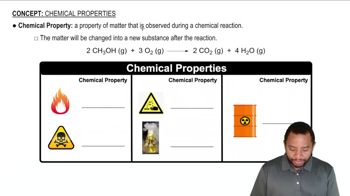Tartaric acid is the white, powdery substance that coats tart candies such as Sour Patch Kids. Combustion analysis of a 12.01-g sample of tartaric acid—which contains only carbon, hydrogen, and oxygen—produces 14.08 g CO2 and 4.32 g H2O. Determine the empirical formula of tartaric acid.
In a popular classroom demonstration, solid sodium is added to liquid water and reacts to produce hydrogen gas and aqueous sodium hydroxide. What is the balanced chemical equation for this reaction?
 Verified step by step guidance
Verified step by step guidanceKey Concepts
Chemical Reactions

Balancing Chemical Equations

Sodium Hydroxide Formation

Sulfuric acid is a component of acid rain formed when gaseous sulfur dioxide pollutant reacts with gaseous oxygen and liquid water to form aqueous sulfuric acid. Write the balanced chemical equation this reaction. (Note: this is a simplified representation of this reaction.)
Nitric acid is a component of acid rain that forms when gaseous nitrogen dioxide pollutant reacts with gaseous oxygen and liquid water to form aqueous nitric acid. Write the balanced chemical equation for this reaction. (Note: this is a simplified representation of this reaction.)
When iron rusts, solid iron reacts with gaseous oxygen to form solid iron(III) oxide. Write the balanced chemical equation for this reaction.
Write the balanced chemical equation for the fermentation of sucrose (C12H22O11) by yeasts in which the aqueous sugar reacts with water to form aqueous ethanol (C2H5OH) and carbon dioxide gas.
